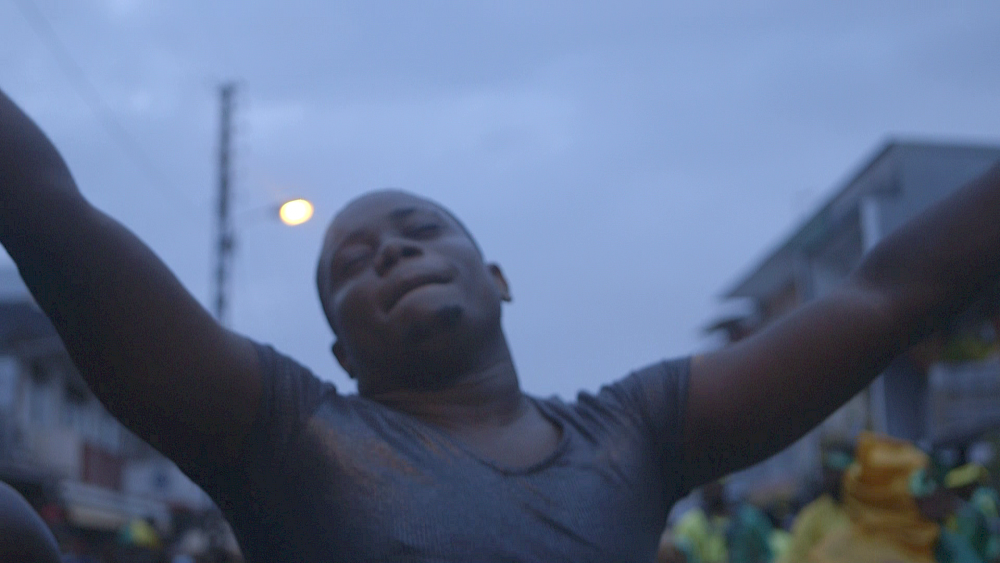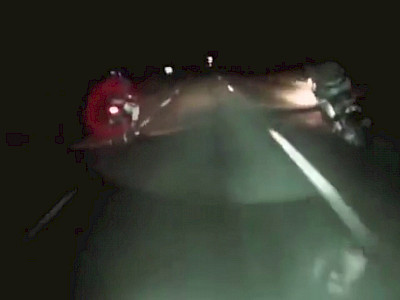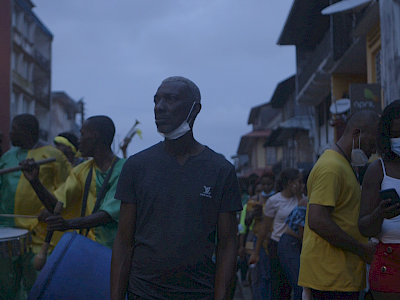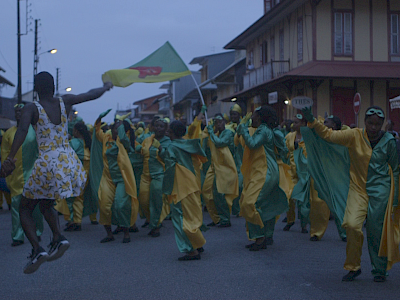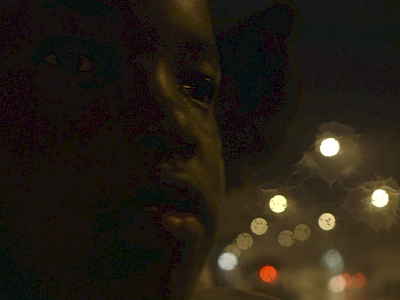17.05, 18.05, 20.05, 21.05.2022
Maxime Jean‑Baptiste Brussels
Entre le Néant et l’Infini, je me mis à pleurer
performance — premiere
| French, Guyanese Creole → NL, FR, EN | ⧖ ±1h20 | €16 / €13
Maxime Jean-Baptiste’s performance starts in the dark. Not just any darkness, but the one of the movie theatre, when the lights go out just before the film begins. The darkness in which to project a film that has not yet been written. Born in 1993 and raised in the context of the Guyanese-Antillean diaspora, Maxime Jean-Baptiste is a filmmaker based in Brussels. In his works he displays an almost choreographic relationship with the moving image. He often starts with found fragments and moves them back and forth, revealing the materiality of the reel and the fabrication of history. In one of his first films he uses a sequence from Jean Galmot, aventurier (1990), dealing with the history of French Guiana, in which his father appears as an extra. The film moves in spasms, like an imprisoned body caught in a narrative from which it has been disappropriated. Starting from his highly refined cinematographic work, Jean-Baptiste builds this performance as a dialogue in a cinema hall (with Sandra Muteteri Herremans), and a journey through a series of images that have accompanied his life. We see a newsitem on the release of the film in which his father appeared, one on the death of his 18-year-old cousin, murdered at a birthday party in Cayenne; and the darkness of a film yet to be written, to regain possession of the narrative of one’s own story.
Entre le Néant et l’Infini, je me mis à pleurer
“The cinema has two bodies, constantly inclining towards each other, appearing to become only one. The body of the films, all the films, which one by one, shot by shot, compose and decompose it. The body of the viewer, affected by its vision of each film, as the index of a theatre of memo-ry, immoderately sized, through each film and mirroring all films. The body of the cinema is the virtual place of their conjunction”.
- Raymond Bellour, Le corps du cinéma. Hypnoses, émotions, animalités, Paris, P.O.L, 2009, p. 16
While investing in video, performance and writing together, the work of Maxime Jean-Baptiste deals essentially with cinema. More than the moving image, this cinema is based on gestures, on bodies and their power, disclosing their antagonism while rekindling their potential for resilience.
Dealing with (post)colonial issues linked to his personal story – as the artist was born in the context of the Guyanese diaspora in France –, his work brings into view the surviving trauma of the colonial past, and the incidence of a level of silence, passed down the generations. His practice thus involves piercing through the consequences that an incomplete History, with its hidden facets, has on a fragmented collective memory, suffering from amnesia because it is dispossessed of its stories, undermined by the pressure of things unsaid and quashed. Throughout his work, the artist thus draws a complex portrait of a social body, to which he gives a voice. The main challenge lies in the frictional intimacy of a composite Guyanese identity, expressed in his work through the poetics of the differences between affiliations, embodiments and distancing.
Maxime Jean-Baptiste’s cinema thus becomes the instrument for counter-narratives, abandoning the linear movement of the smoothed image in favour of the gestures which shape it, the escaping jolts, confrontational perspectives and the voices which people it.
Gestures to the image, gestures of the image, fervent orality, these are the tonalities and materials used, along with the figures that he borrows, quotes and combines for various re-enactments. These choreographed acts are repeated and moved back and forth on the screen, cross the limits and their own temporalities as if to try to crea-te the materiality of a present haunted by its blind spots and its clichéd identities. Hence, his work participates in a policy of the image which aims at a firm denial of the prescriptive dominant eye, focused only on the Black body, especially as it is framed by the narrative cinema, the entertainment industry or the media. It is from the position of an “incredulous and resistant” viewer (Manthia Diawara, « Black Spectatorship: Problems of Identification and Resistance » in Screen, Autumn 1988, vol 29 no 4, pp. 66-79) in fact, that Maxime Jean-Baptiste has placed the markers of his cinematographic language, joining the post-colonial field as he transforms the issue of passive identification into an active critique. His approach to cinema is supported especially by various photo-filmic treatments he applies to these found footage images, operations which are clearly asserted as such, disturbing the film itself as it unwinds in jerks, thus revealing the invisible joins beneath the moving image. These visual jolts, like conscious or reflex spasms, evoke the literal and symbolic contortions taking place in the field of History and maimed memories, stuck between memories of absence and absence of memories. This is especially what these silhouettes symbolise in his two earlier videos, Nou voix (2018) and Moune Ô (2021), as they move painfully, trapped in a carousel of mishaps.
The cinema of Maxime Jean-Baptiste thus unfolds in a spectral atmosphere, expressing an absence, a return, both held in check in the image, while this flow slows, dissipates, leads into a decentred temporality, which “does not flow” (Julia Kristeva, Soleil Noir. Dépression et mélancolie, Paris, Gallimard, pp. 70-71). This visual grammar in reality charts the pathological, melancholic character (Paul Gilroy, Mélancolie postcoloniale, Paris, B42, 2020) of a contemporary situation, and especially of the ambiguous relationship maintained between the metropolitan powers and their former colonies, and the consequences a dominant imagery has over othered bodies. From slow retrospectives, as the cinema’s hypnotic force is defused, these discontinuities do however come to erode the mechanism by which these clichés are embedded. The audience is then projected into a cosmos in tension, from where the artist will return before transforming it into a new ideal.
Entre le Néant et l’Infini, je me mis à pleurer, this new performance piece produced by the Kunstenfestivaldesarts, takes its title from a quotation of Franz Fanon referring to the experience the author created from the dark room, anticipating an encounter with his own image, beneath phantasmagoric, even obscene features. The performance piece hinges on shots taken from his latest film, Kouté Vwa (meaning “hear the voices” in Guyanese Creole), presently in production, extracts here linked with several other fragments brought in speech, music and dance, alongside the artist Sandra Muteteri Heremans. This new work raises the tragic reality of an event in 2012, the brutal assassination of his 18-year-old cousin Lucas Diomar, at a birthday evening. The 10th anniversary of the death was marked at the time his murderers left prison. Although he documented this commemoration, the theft of his computer on his return from Guyana has left the artist bereft, without images, faced with a void. A void around which this performance is built. The artist brings together an aesthetic from the archive and from witnesses, compiling the texts and the rushes of a second film shoot, materials taken on the spot between “here” and “there”, to give body to a contemporary tragedy, beneath the motif of a fostering violence which youth turns back against itself. On the stage, the “invisible evidence” emerges in the interlinked sub-texts of the image and text, engendering this obscure, thoughtful bulk, carrying the traumas like a tarry substance, along with, powerfully, their possible alternatives and resolutions.
- Pauline Hatzigeorgiou, April 2022
- Pauline Hatzigeorgiou (1989, Brussels) trained in the history of modern and contemporary art at ULB and UCL. Since 2015, she has worked as a curator and researcher, mediator, author (member of AICA) and teacher-lecturer in art academies and graduate schools (particularly ArBA-ESA). In 2018, she was a founder member and curator of the SB34 association. She also collaborates with institutions (Bozar, WIELS, Iselp) and alternative venues in Brussels. In her projects and research, she pays special attention to methods of production, visibility and social awareness of artwork in the field of exhibitions.
Presentation: Kunstenfestivaldesarts, Le Rideau
Concept,direction: Maxime Jean-Baptiste | Performers: Maxime Jean-Baptiste, Sandra Muteteri Heremans | Images: Maxime Jean-Baptiste, Arthur Lauters, Alain Maline | Conductor: Sophye Soliveau | Surtitles and translation: Babel Subtitling
Spectre Productions | Commissioned and coproduced by Kunstenfestivaldesarts
